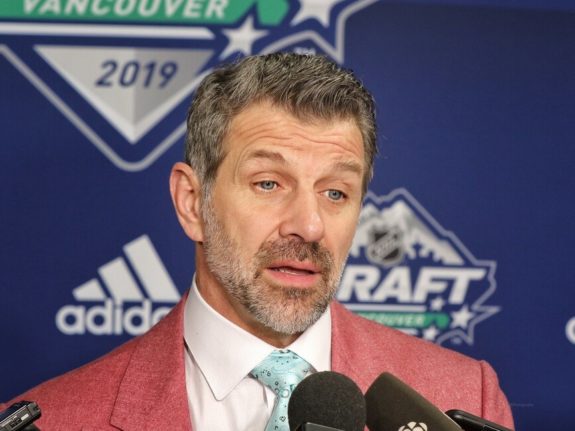Sometimes a good trade isn’t a good move. The Montreal Canadiens’ trade for Eric Staal proves that.
To his credit, Canadiens general manager Marc Bergevin acquired a potential top-six forward in Staal, who plays a largely in-demand position at center, for a couple of mid-round picks. Furthermore, he got the Buffalo Sabres to retain half the pending unrestricted free agent’s salary, which is critical considering the Canadiens’ tight cap situation down the stretch.
However, that tight cap situation is in large part the problem.
Staal Trade in a Vacuum
Under normal circumstances, acquiring Staal for depth purposes would be welcome, especially considering the deal Bergevin got. In effect, looking at the trade itself in a vacuum, you’d be hard-pressed to find fault with it. After all, the Canadiens get extra depth down the middle, at a position in which Phillip Danault, at age 28, is their elder statesman. Adding a veteran of Staal’s level of (Stanley Cup-winning) experience makes sense on a variety of levels. However, with the cap flat at $81.5 million and the Habs missing bigger pieces to the puzzle, using a big chunk of the space the Habs have left on Staal is less than ideal.

As a result, the Habs have much less room to maneuver to say, acquire a left-handed, puck-moving defenseman to play with Shea Weber, which is perhaps their biggest need. If Staal were a No. 1 center, it might be a different story, because the Habs lack one of those as well, but he isn’t. No longer anyway. Simply put, Bergevin failed to address a huge need. As decent of an acquisition as Staal is, Bergevin may have failed to address one altogether.
The Canadiens are not lacking in offensive talent up front. In fact, with an 11th-ranked 3.19 goals per game, the Habs technically have a more efficient offense than in 2007-08 (3.13) when Alexei Kovalev led a powerhouse corps up front that boasted seven different 50-point scorers.
Every little bit does admittedly help. However, anyone thinking Staal will suddenly become a point-per-game player again on the Canadiens is neglecting to consider a few key factors.
Staal vs. Lehkonen?
Firstly, at 36 years of age, Staal’s in decline. Sure, as recently as 2019-20, Staal was a decent offensive contributor with the Minnesota Wild (47 points in 66 games). This season, in which he has just 10 points in 32 games, can realistically be considered an outlier considering the environment in which he had been playing, where even ex-Hart Memorial Trophy-winner Taylor Hall has been limited to two goals and 17 points in 33 games with the Buffalo Sabres. Fair enough.
However, someone’s going to have to come out of the lineup to make room for Staal. It might be Jake Evans, who has just two goals and three assists in 29 games in a fourth-line role. Perhaps more realistically, it will be Artturi Lehkonen, a fellow left-handed shot relative to Staal, who, similarly on the Habs’ fourth line, has just two goals and two assists in 22 games, having been a regular scratch.

In either case, it’s fairly logical to assume Staal will assume a depth role, with fewer offensive opportunities and less resulting points. For his part, he seems to understand that may be the case, saying at a media-availability session during his quarantine: “I want to play 25 minutes every game… Obviously, you have to fill roles, but you always have to try to push yourself to be your best.”
The Habs presumably like what they’re hearing and he’s saying all the right things, but things don’t necessarily work out like you think. Case in point, Evans and Lehkonen make for easy targets and whipping boys, because of their relatively low point totals, but the idea had initially been to roll four offensively capable lines. In theory, each line as it appears on paper is just that, but, in practice, it works out differently.
Looking specifically at Lehkonen, his offensive zone starting percentage has taken a serious hit to the point he is starting less than 40% of shifts in the opponents’ zone, per Hockey Reference. That’s a career low. Keep in mind, as recently as last season, Lehkonen was fourth on the team in terms of point production at five on five (per-60 minutes).
It takes a radically different deployment strategy to significantly impact a player in his mid-20s like that. It’s not like Lehkonen suddenly started playing the wrong way. The Habs arguably started playing Lehkonen the wrong way… and it’s not necessarily their fault either. Someone’s going to have to take the harder assignments. It may as well be Lehkonen.
If Lehkonen is no longer around though, if either as a healthy scratch or as trade bait to make more cap space? That responsibility will fall on someone else. Staal turning out differently is unlikely to come to pass. And, if Staal gets deployed higher in the lineup? Someone will have to drop down, yielding much the same net result. Considering Staal’s no longer in his prime, maybe worse.
Is Bergevin Really Done?
True, Staal may help out on faceoffs, an admitted Achilles Heel for the Habs. However, he hasn’t earned a percentage above 50% in the dot since 2018-19 with the Minnesota Wild. Even if he does regain his prowess there, he’d have to be played significantly to have much of an impact, especially considering the correlation between faceoffs and overall winning percentage or lack thereof. If Staal’s deployed more than he should be, that could have a domino effect, adversely impacting other areas in the Habs’ game.
Chemistry is not the concern here. Staal has enough veteran experience that, if he’s played correctly, he should help rather than hinder the Habs. Instead, it’s whether or not Staal at forward will push the team over the edge when a player like Mattias Ekholm (for example) on defense would have had a better chance at so doing.
To be fair, considering Bergevin had said prior to the Staal acquisition that he didn’t see himself making a move because of the Canadiens’ cap situation, all in all it should be hard for Habs fans to be upset with the trade. However, it’s ultimately like buying a gallon of milk that’s just about to expire for breakfast and realizing you have no cereal in the house. You can certainly use it for other things, but, ultimately, you probably would have preferred to use your cash on the cereal instead.

The Canadiens are a better team right now than they were a week ago. However, it remains to be seen if they’re good enough. Bergevin reiterated the notion that he is not looking to move any additional cap space to make moves ahead of the upcoming trade deadline when talking to the media about the Staal trade. Considering the reaction to the statement was a general sense of “fool me once, shame on you…” many seem to acknowledge the obvious. It isn’t simply that more needs to be done, but, rather, that something different had to be. It’s a paradox. By itself the deal is great, but, if that’s the only deal there is, it leaves something to be desired… namely more help on defense.